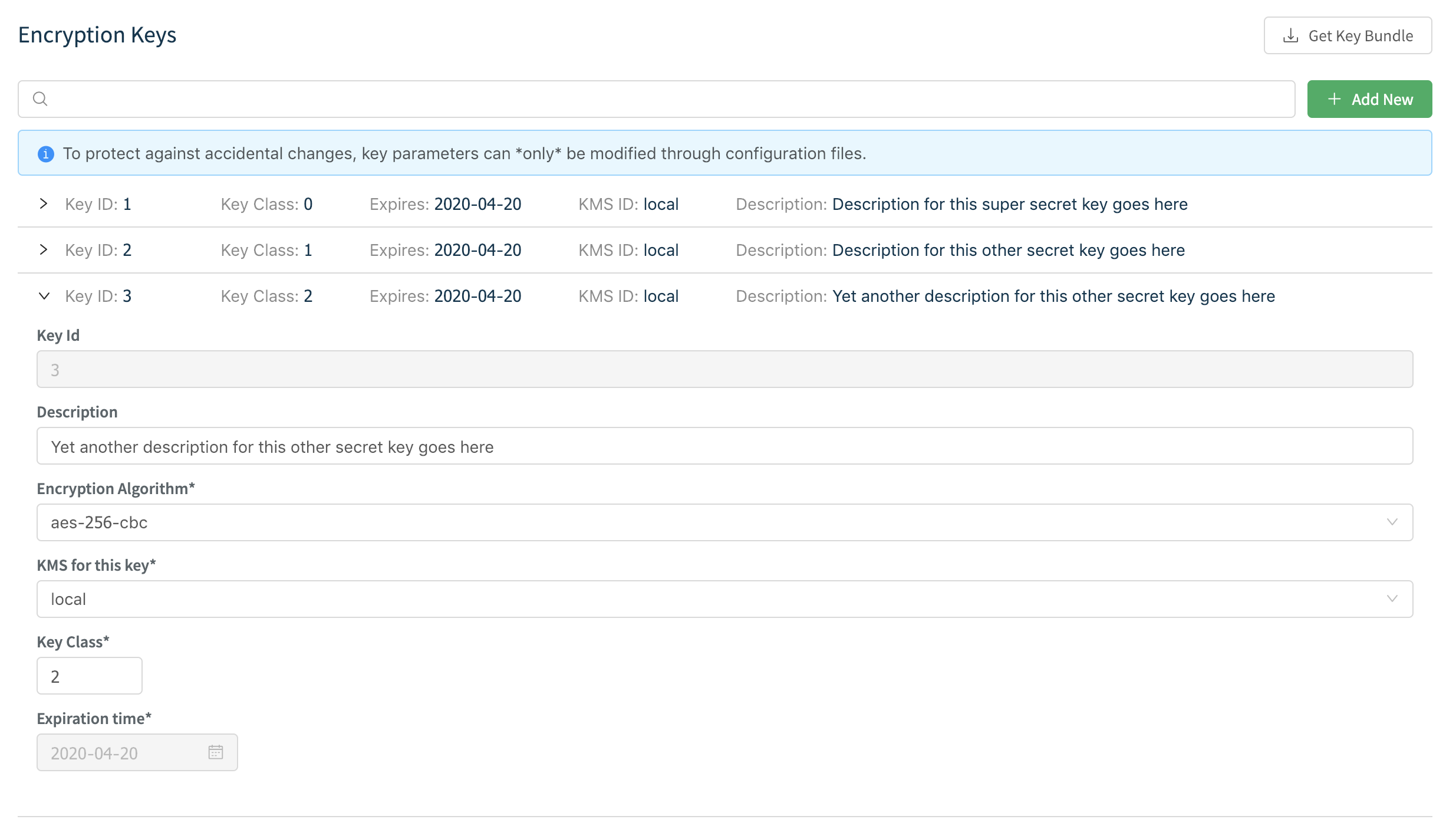These docs are for Cribl Stream 4.0 and are no longer actively maintained.
See the latest version (4.15).
Encryption
Encryption of Data in Motion
With Cribl Stream, you can encrypt fields or patterns within events in real time, by using C.Crypto.encrypt() in a Mask function. The Mask function accepts multiple replacement rules and multiple fields to apply them to.
A Match regex defines the pattern of content to be replaced. The Replace expression is a JS expression or literal to replace matched content. The C.Crypto.encrypt() method can be used here to generate an encrypted string from a value passed to it.
C.Crypto.encrypt() Syntax
(method)
Crypto.encrypt(value: any, keyclass: number, keyId?: string, defaultVal?: string): stringEncrypt the given value with thekeyId, or with akeyIdpicked up automatically based onkeyclass.@param {string | Buffer}
value- what to encrypt. @param -keyclass- ifkeyIdisn’t specified, pick one at the givenkeyclass. @param -keyId- encryption keyId, takes precedence overkeyclass. @param -defaultVal- what to return if encryption fails for any reason; if unspecified, the original value is returned. @returns - if encryption succeeds, the encrypted value; otherwise,defaultValif specified; otherwise,value.
Encryption Keys
Symmetric keys can be configured through the CLI or UI. Users are free to define as many keys as required. Each key is characterized by the following:
keyId: ID of the key.algorithm: Algorithm used with the keykeyclass: Cribl Key Class (below) that the key belongs to.kms: Key management system for the key. Defaults tolocal.created: Time (epoch) when key was generated.expires: Time (epoch) after which the key is invalid. Useful for key rotation.useIV: Flag that indicates whether or not an initialization vector was used.
Key Classes
Key Classes in Cribl Stream are collections of keys that can be used to implement multiple levels of access control. Users (or groups of users) with access to data with encrypted patterns can be associated with key classes, for even more granular, pattern-level compartmentalized access.
Example
Users U0, U1 have been given access to keyclass 0 which contains key IDs 0 and 1. These keys are used to encrypt certain patterns in datasetA. Even though users U0, U1, U2 have access to read this dataset, only U0 and U1 can decrypt its encrypted patterns.
| Key Class | Dataset |
|---|---|
keyclass: 0Keys: keyId: 0, keyId: 1Users: U0, U1 | datasetAUsers: U0, U1, U2 |
User U1 has been given access to an additional keyclass, 1, which contains key IDs 11 and 22. These keys are used to encrypt certain other patterns in datasetA. Even though users U0, U1, U2 have access to read this dataset - same as above - only U1 can decrypt the additional encrypted patterns.
| Key Class | Dataset |
|---|---|
keyclass: 1Keys: keyId: 11, keyId: 22Users: U1 | datasetAUsers: U0, U1, U2 |
Configuring Keys with the CLI
When using the local key management system, encryption keys in Cribl Stream are encrypted with $CRIBL_HOME/local/cribl/auth/cribl.secret and stored in $CRIBL_HOME/local/cribl/auth/keys.json. Cribl monitors the keys.json file for changes every 60 seconds.
When installed as a Splunk app,
$CRIBL_HOMEis$SPLUNK_HOME/etc/apps/cribl.
Listing Keys
Keys are added and listed using the keys command:
$CRIBL_HOME/bin/cribl keys list -g <workerGroupID>
keyId algorithm keyclass kms created expires useIV
-----------------------------------------------------------------------
1 aes-256-cbc 0 local 1544906269.316 0 false
2 aes-256-cbc 1 local 1544906272.452 0 false
3 aes-256-cbc 2 local 1544906275.948 1545906275 true
4 aes-256-cbc 3 local 1544906278.026 0 falseAdding Keys
Displaying --help:
$CRIBL_HOME/bin/cribl keys add --help
Add encryption keys
Usage: [options] [args]
Options:
[-c <keyclass>] - key class to set for the key
[-k <kms>] - KMS to use, must be configured, see cribl.yml
[-e <expires>] - expiration time, epoch time
[-i] - use an initialization vector
-g <group> - Group IDAdding a key to keyclass 1, with no expiration date, on the default Worker Group:
$CRIBL_HOME/bin/cribl keys add -c 1 -i -g default
Adding key: success. Key count=1(You would use the same syntax to reference a non-default Worker Group by its name.)
?
Listing keys to verify key generation:
$CRIBL_HOME/bin/cribl keys list -g default
keyId algorithm keyclass kms created expires useIV
-----------------------------------------------------------------------
1 aes-256-cbc 1 local 1545243364.342 0 trueConfiguring Keys with the UI
In a single-instance deployment, you can access the key management interface through Settings > Security > Encryption Keys. In a distributed deployment, for each Group, select Manage > <group-name> > Group Settings > Security > Encryption Keys.
Here, you can list and add new keys. To protect against accidental changes, a key’s parameters, once saved, can be edited only through configuration files.

Sync auth/(cribl.secret|keys.json)
Cribl Stream performs decryption only when the data is being sent to Splunk. For details, see Decryption of Data in Splunk
To successfully decrypt data, the decrypt command will need access to the same keys that were used to encrypt, in the Cribl instance where encryption happened.
In a single-instance deployment, the
cribl.secretandkeys.jsonfiles reside in:$CRIBL_HOME/local/cribl/auth/.In a distributed deployment, the
cribl.secretandkeys.jsonfiles reside on the Leader Node in:$CRIBL_HOME/groups/<group-name>/local/cribl/auth/.When using the UI, you can download these files by clicking the **Get Key Bundle **button.
Sync/copy these files over to their counterparts on the Search Head/decrypting side, residing in: $SPLUNK_HOME/etc/apps/cribl/local/cribl/auth/.
Modifying Keys
When you update keys by editing the keys.json file, you must add them back to the directories above (respectively, on a single instance or on a distributed deployment’s Leader Node).





